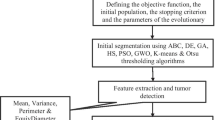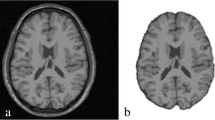Abstract
The performance of medical image segmentation is generally affected by the parameters of the adopted method and noise. To overcome these issues we introduce in this paper a novel segmentation approach of brain MRI using a region based-active contour model and evolutionary algorithm and without performing any pre-processing step. Our main objective is to accurately extract edges, resolve the intensity inhomogeneity problem and overcome manifestations of noise. Chan and Vese model was adopted by introducing a local similarity factor based on Bilateral filter principle (LSFB). The adjustment of our functional energy parameters was achieved using a multi-population genetic algorithm (MPGA) which can display better search performance than serial single population models, in terms of the quality of the solution found, effort and processing time. We selected Brain MRI from Oasis and Brainweb data base with different noise type. The initialization of the active contour was totally random. A comparison of segmentation results with Chan and Vese model and active contour model with a locally computed signed pressure force (SPF) of Akram and his team reveals a clear efficiency of our proposed approach.










Similar content being viewed by others
REFERENCES
T. Chan and L. Vese, “Active contour without edges,” EEE Trans. Image Process. 10 (2), 266–277 (2001).
M. Kass, A. Witkin, and D. Terzopoulos, “Snakes: Active contour models,” Int. J. Comput. Vision 1 (4), 321–331 (1988).
V. Caselles, R. Kimmel, and G. Sapiro, “Geodesic active contours,” Int. J. Comput. Vision 22 (1), 61–79 (1997).
G. Zhu, S. Zhang, Q. Zeng, and C. Wang, “Boundary-based image segmentation using binary level set method,” Opt. Eng. 46 (5), 050501–050501 (2007).
J. Lie, M. Lysaker, and X. C. Tai, “A binary level set model and some application to Mumford–Shah image segmentation,” IEEE Trans. Image Process. 15 (5), 1171–1181 (2006).
L. Wang, C. Li, Q. Sun, D. Xia, and C. Y. Kao, “Active contours driven by local and global intensity fitting energy with application to brain MR image segmentation,” Comput. Med. Imaging Graphics 33 (7), 520–531 (2009).
L. Chen, Y. Zhou, Y. Wang, and J. Yang, “GACV: Geodesic-aided C–V method,” Pattern Recognit. 39 (7), 1391–1395 (2006).
C. Li, C. Y. Kao, J. C. Gore, and Z. Ding, “Minimization of region-scalable fitting energy for image segmentation,” IEEE Trans. Image Process. 17 (10), 1940–1949 (2008).
W. A. Fares, A. Herbulot, M. Devy, E. H. Bouyakhf, and F. Regragui, “Une nouvelle approche des contours actifs bases region utilisantune information locale et globale,” in 23eme Colloque GRETSI sur le Traitement du Signal et des Images (2011).
H. Xu, G. Jiang, M. Yu, and T. Luo, “A global and local active contour model based on dual algorithm for image segmentation,” Comput. Math. Appl. 74 (6), 1471–1488 (2017).
S. Niu, Q. Chen, L. de Sisternes, Z. Ji, Z. Zhou, and D. L. Rubin, “Robust noise region-based active contour model via local similarity factor for image segmentation,” Pattern Recognit. 61, 104–119 (2017).
S. Osher and J. A. Sethian, “Fronts propagating with curvature dependent peed: Algorithms based on Hamilton–Jacobi formulations,” J. Comput. Phys. 79, 12–49 (1988).
A.-R. Mansouri, T. Chomaud, and J. Konrad, “A comparative evaluation of algorithms for fast computation of level set PDES with applications to motion segmentation,” in Proceedings 2001 International Conference on Image Processing (2001), pp. 636–639.
C. Serief, “Combination of the geodesic active contours with a pyramidal approach,” in Conference Internationale sur les Systèmes de Télécommunications, d’Électronique Médicale et d’Automatique CISTEMA (2003).
F. Z. Belgrana, N. Benamrane, and A. Taleb-Ahmed, “Adjustment of active contour parameters in brain MRI segmentation using evolution strategies,” in 4th International Conference on Electrical Engineering (ICEE) (2015), pp. 1–7.
A. Maalouf, P. Carré, B. Augereau, and Fernandez-Maloigne, C., “Cooperation of the partial differential equation methods and the wavelet transform for the segmentation of multivalued images,” Signal Process.: Image Commun. 23 (1), 14–30 (2008).
S. Balla-Arabé and X. Gao, “Image multi-thresholding by combining the lattice Boltzmann model and a localized level set algorithm,” Neurocomputing 93, 106–114 (2012).
F. Z. Belgrana and N. Benamrane, “A fast and robust segmentation of magnetic resonance brain images using a combination of the pyramidal approach and level set method,” Int. J. Imaging Syst. Technol. 27 (2), 182–182 (2016).
E. Ilunga-Mbuyamba, J. G. Avina-Cervantes, A. Garcia-Perez, R. de Jesus Romero-Troncoso, H. Aguirre-Ramos, I. Cruz-Aceves, and C. Chalopin, “Localized active contour model with background intensity compensation applied on automatic MR brain tumor segmentation,” Neurocomputing 220, 84–97 (2017).
D. Whitley, S. Rana, and R. B. Heckendorn, “Island model genetic algorithms and linearly separable problems,” in AISB International Workshop on Evolutionary Computing (1997), pp. 109–125.
D. Mumford and J. Shah, “Optimal approximations by piecewise smooth functions and associated variational problems,” Commun. Pure Appl. Math. 42, 577–685 (1989).
S. Paris, P. Kornprobst, J. Tumblin, and F. Durand, “Bilateral filtering: Theory and applications,” Found. Trends Comput. Graphics Vision 4 (1), 1–73 (2009).
T. Bäck, G. Rudolph, and H. P. Schwefel, “Evolutionary programming and evolution strategies: Similarities and differences,” in Proceedings of the Second Annual Conference on Evolutionary Programming (1993).
M. Antonelli, M. J. Cardoso, E. W. Johnston, M. B. Appayya, B. Presles, M. Modat, and S. Ourselin, “GAS: A genetic atlas selection strategy in multi-atlas segmentation framework,” Med. Image Anal. 52, 97–108 (2019).
S. Abdel-Khalek, A. B. Ishak, O. A. Omer, and A. S. Obada, “A two-dimensional image segmentation method based on genetic algorithm and entropy,” Optik 131, 414–422 (2017).
N. Soni and T. Kumar, “Study of various mutation operators in genetic algorithms,” Int. J. Comput. Sci. Inf. Technol. 5 (3), 4519–4521 (2014).
Oasis. https://www.oasis–brains.org/
Brain Web. https://brainweb.bic.mni.mcgill.ca/brainweb/
F. Akram, J. H. Kim, H. U. Lim, and K. N. Choi, “Segmentation of intensity inhomogeneous brain MR images using active contours,” Comput. Math. Methods Med. 2014 (2014).
D. L. Collins, A. P. Zijdenbos, V. Kollokian, J. G. Sled, N. J. Kabani, C. J. Holmes, and A. C. Evans, “Design and construction of a realistic digital brain phantom,” IEEE Trans. Med. Imaging 17 (3), 463–468 (1998).
Author information
Authors and Affiliations
Corresponding authors
Ethics declarations
We would like to thank everybody who has contributed to this work.
The authors declare that they have no conflicts of interest.
This article does not contain any studies involving animals performed by any of the authors.
This article does not contain any studies involving human participants performed by any of the authors.
Additional information

Fatima Zohra Belgrana obtained her engineering degree from University of science and technology of Oran “Mohamed Boudiaf,” USTO-MB, Algeria in 2005. She obtained a Magister degree in 2008 and PhD in 2017 in medical image processing from the same university. She is a member of SIMPA laboratory. She specializes in the area of image processing, distributed systems, artificial intelligence, evolutionary algorithm, neural networks and active contour for medical applications. Belgrana currently holds the position of an associate professor at the University Center “Belhadj Bouchaib” of Ain Temouchent, CUBBAT, Algeria.

Nacéra Benamrane is currently a full professor and a director of SIMPA laboratory in informatics department at University of Science and Technology of Oran-Mohamed Boudiaf (USTO-MB). She received her engineering degree in Computer Science from University of Oran, the M.Sc. and Ph.D. degrees from University of Valenciennes, France Since 2002, she is the head of vision and medical imaging team at SIMPA laboratory. She has published more than 100 papers in journals and conference proceedings. Her main research interests include image processing, medical imaging, computer vision, biomedical engineering, and pattern recognition.

Sid Ahmed Kasmi obtained his engineering degree from University of science and technology of Oran “Mohamed Boudiaf,” USTO-MB, Algeria. He obtained a Master degree from the same university in 2017. He actually holds the position of teacher in mathematics.
Rights and permissions
About this article
Cite this article
Belgrana, F.Z., Benamrane, N. & Kasmi, S.A. A Hybrid Segmentation Approach of Brain Magnetic Resonance Imaging Using Region-Based Active Contour with a Similarity Factor and Multi-Population Genetic Algorithm. Pattern Recognit. Image Anal. 30, 765–777 (2020). https://doi.org/10.1134/S1054661820040069
Received:
Revised:
Accepted:
Published:
Issue Date:
DOI: https://doi.org/10.1134/S1054661820040069




